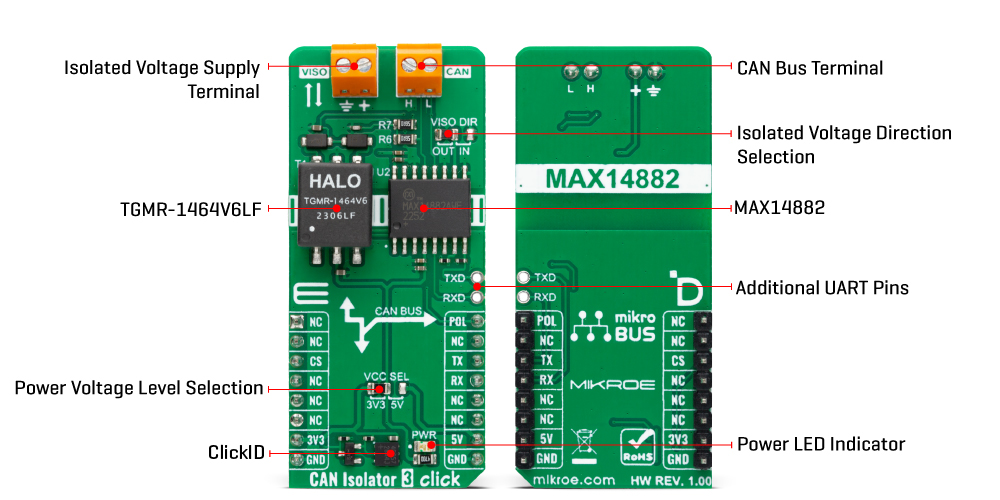OFF
GO LOCAL
| Company | Stock | Price |
|---|---|---|

MIKROE-5785
22 g
Status:
CAN Isolator 3 Click is a compact add-on board that provides isolated CAN communication. This board features the MAX14882, an isolated CAN transceiver with an integrated transformer driver from Analog Devices. It is galvanically isolated between the device's CAN-protocol controller side (TDX, RDX) and the physical wires of the CAN network (CANH, CANL) cable-side/bus-side of the transceiver. The MAX14882 provides up to 5kVRMS of galvanic isolation for 60 seconds and a continuous working voltage of up to 848VRMS while operating at the maximum high-speed CAN data rate of 1Mbps. Also, one of the most essential features of this board is the possibility of its independent generation of isolated voltage. This Click board™ makes the perfect solution for the development of automation, industrial controls, HVAC, switching gears, and more.
CAN Isolator 3 Click is fully compatible with the mikroBUS™ socket and can be used on any host system supporting the mikroBUS™ standard. It comes with the mikroSDK open-source libraries, offering unparalleled flexibility for evaluation and customization. What sets this Click board™ apart is the groundbreaking ClickID feature, enabling your host system to seamlessly and automatically detect and identify this add-on board.
This product is no longer in stock
Availability date:
OFF
| Company | Stock | Price |
|---|---|---|

CAN Isolator 3 Click is based on MAX14882, an isolated CAN transceiver with an integrated transformer driver from Analog Devices. Its features include a wide supply voltage range for the CAN controller interface (3V – 5V), field bus polarity control (POL), an integrated transformer driver for power transfer to the bus side, and an integrated LDO for powering the CAN bus side. The CAN bus controller exceeds the ISO 11898 specifications requirement of -2V to +7V with ±25V receiver input common-mode range. Additionally, the CANH and CANL IOs are fault tolerant up to ±54V and protected from electronic discharge (ESD) up to ±15KV to GNDB on the bus side.

CAN Isolator 3 Click is equipped with CAN and VISO terminals, where the VISO terminal can be a bus-side power input or an LDO power output terminal. If used as an LDO power output, you can count up to 5V of VDDB voltage on this terminal. You can select the input/output direction over the VISO DIR jumper, where the isolated voltage as output (OUT) is set by default. In this default configuration, the reinforced insulation module can supply to the VISO terminal 3.3V or 5V, depending on the selected voltage on the VCC SEL jumper, as the 3.3V is selected by default.
CAN Isolator 3 Click uses a standard UART serial interface to communicate with the host MCU over commonly used UART RX and TX pins. The RX and TX are also available on a separate header for testing purposes. The polarity of the CAN controller can be set over the POL pin with a LOW logic state for normal CANH and CANL operation and HIGH to swap the functions of the CANH and CANL.
This Click board™ can operate with either 3.3V or 5V logic voltage levels selected via the VCC SEL jumper. This way, both 3.3V and 5V capable MCUs can use the communication lines properly. Also, this Click board™ comes equipped with a library containing easy-to-use functions and an example code that can be used, as a reference, for further development.
Type
CAN
Applications
Can be used for the development of automation, industrial controls, HVAC, switching gears, and more
On-board modules
MAX14882 - isolated CAN transceiver with an integrated transformer driver from Analog Devices
Key Features
Good galvanic isolation, wide supply voltage range for CAN controller interface, field bus polarity control, integrated transformer driver for power transfer to Bus-side, integrated LDO for powering CAN Bus-side, fault protection, VISO terminal can be used as a Bus-side power input or an LDO power output, and more
Interface
UART
Feature
ClickID
Compatibility
mikroBUS™
Click board size
L (57.15 x 25.4 mm)
Input Voltage
3.3V or 5V
This table shows how the pinout on CAN Isolator 3 Click corresponds to the pinout on the mikroBUS™ socket (the latter shown in the two middle columns).
| Label | Name | Default | Description |
|---|---|---|---|
| LD1 | PWR | - | Power LED Indicator |
| JP1 | VCC SEL | Left | Power/Logic Voltage Level Selection 3V3/5V: Left position 3V3, Right position 5V |
| JP2 | VISO DIR | Left | Isolated Voltage Direction Selection OUT/IN: Left position OUT, Right position IN |
| Description | Min | Typ | Max | Unit |
|---|---|---|---|---|
| Supply Voltage | 3.3 | - | 5 | V |
| Insulation Barrier | - | - | 5000 | Vrms |
| Maximum Duration of Isolation | - | - | 60 | sec |
| Data Rate | - | - | 1 | Mbps |
| ESD Protection (HBM) | - | ±15 | - | kV |
We provide a library for the CAN Isolator 3 Click as well as a demo application (example), developed using MIKROE compilers. The demo can run on all the main MIKROE development boards.
Package can be downloaded/installed directly from NECTO Studio Package Manager (recommended), downloaded from our LibStock™ or found on Mikroe github account.
Library Description
This library contains API for CAN Isolator 3 Click driver.
Key functions
canisolator3_generic_write CAN Isolator 3 data writing function.
canisolator3_generic_read CAN Isolator 3 data reading function.
canisolator3_set_pol_pin CAN Isolator 3 set polarity function.
Example Description
This example writes and reads and processes data from CAN Isolator 3 Click. The library also includes a function for selection of the output polarity.
void application_task ( void )
{
#ifdef DEMO_APP_TRANSMITTER
canisolator3_generic_write( &canisolator3, TX_MESSAGE, strlen( TX_MESSAGE ) );
log_info( &logger, "---- Data sent ----" );
Delay_ms( 2000 );
#else
canisolator3_process( &canisolator3 );
#endif
}
The full application code, and ready to use projects can be installed directly from NECTO Studio Package Manager (recommended), downloaded from our LibStock™ or found on Mikroe github account.
Other Mikroe Libraries used in the example:
Additional notes and informations
Depending on the development board you are using, you may need USB UART click, USB UART 2 Click or RS232 Click to connect to your PC, for development systems with no UART to USB interface available on the board. UART terminal is available in all MIKROE compilers.
This Click board™ is supported with mikroSDK - MIKROE Software Development Kit. To ensure proper operation of mikroSDK compliant Click board™ demo applications, mikroSDK should be downloaded from the LibStock and installed for the compiler you are using.
For more information about mikroSDK, visit the official page.
NOTE: Please be advised that any peripheral devices or accessories shown connected to the Click board™ are not included in the package. Check their availability in our shop or in the YMAN section below.